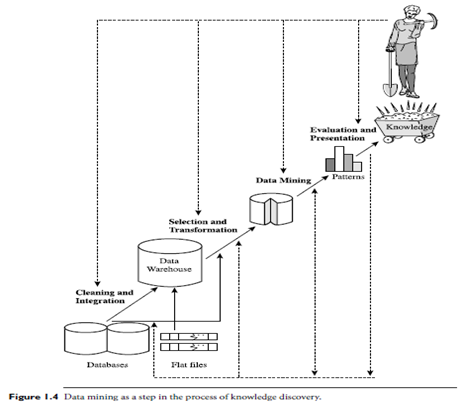Introduction To Data Mining
Introduction: Data mining refers to extracting or “mining” knowledge from large amounts of data. The term is actually a misnomer. Remember that the mining of gold from rocks or sand is referred to as gold mining rather than rock or sand mining. Thus, data mining should have been more appropriately named “knowledge mining from data,”
This is unfortunately somewhat long. “Knowledge mining,” a shorter term may not reflect the emphasis on mining from large amounts of data. Nevertheless, mining is a vivid term characterizing the process that finds a small set of precious nuggets from a great deal of raw material. Thus, such a misnomer that carries both “data” and “mining” became a popular choice. Many other terms carry a similar or slightly different meaning to data mining, such as knowledge mining from data, knowledge extraction, data/pattern analysis, data archaeology, and data dredging.
Many people treat data mining as a synonymfor another popularly used term, Knowledge Discovery fromData, or KDD. Alternatively, others view data mining as simply anessential step in the process of knowledge discovery. Knowledge discovery as a process is depicted in Figure 1.4 and consists of an iterative sequence of the following steps:

1. Data cleaning (to remove noise and inconsistent data)
2. Data integration (where multiple data sources may be combined)1
3. Data selection (where data relevant to the analysis task are retrieved fromthe database)
4. Data transformation (where data are transformed or consolidated into forms appropriate for mining by performing summary or aggregation operations, for instance)2
5. Data mining (an essential process where intelligent methods are applied in order to extract data patterns)
6. Pattern evaluation (to identify the truly interesting patterns representing knowledge based on some interestingness measures; Section 1.5)
7. Knowledge presentation (where visualization and knowledge representation techniques are used to present the mined knowledge to the user)
Steps 1 to 4 are different forms of data preprocessing, where the data are prepared for mining. The data mining step may interact with the user or a knowledge base. The interesting patterns are presented to the user and may be stored as new knowledge in the knowledge base. Note that according to this view, data mining is only one step in the entire process, albeit an essential one because it uncovers hidden patterns for evaluation.
We agree that data mining is a step in the knowledge discovery process. However, in industry, in media, and in the database research milieu, the term data mining is becoming more popular than the longer term of knowledge discovery from data. Therefore, in this book, we choose to use the term data mining. We adopt a broad view of data mining functionality: data mining is the process of discovering interesting knowledge from large amounts of data stored in databases, data warehouses, or other information repositories.